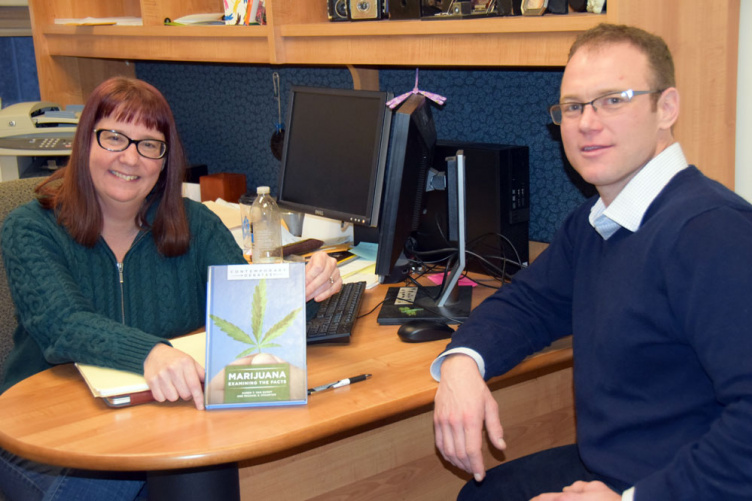
Karen Van Gundy and Michael Staunton co-authored the new book "Marijuana: Examining the Facts."
A dangerous gateway drug? A harmless recreational substance? Something in between? In their new book “Marijuana: Examining the Facts,” Karen T. Van Gundy and Michael S. Staunton look at the data that can help provide answers to these questions and more.
About the Authors
Karen Van Gundy teaches undergraduate and graduate courses on drugs and society and publishes research and policy reports that consider various aspects of substance use and misuse.
Her scholarly writing has appeared in publications including the Journal of Health and Social Behavior, Rural Sociology and Substance Use and Misuse. Her current work examining the health-related impact of social contexts among rural and urban youth and emerging adults is funded by two National Science Foundation grants and by the New Hampshire Charitable Foundation.
Michael Staunton is a doctoral candidate at UNH whose most recent work includes grant-funded research on the links between social context and health outcomes among rural youth.
His master's thesis examined the effects of socioeconomic status and mastery on goal-striving stress among rural New Hampshire youth. He has published public-policy briefs on various issues among rural American populations.
“It’s the sort of book I thought I would want to write, and it was time for us to have a book like this,” explains Van Gundy, associate professor of sociology, core faculty in justice studies and faculty fellow at UNH’s Carsey School of Public Policy. “But we didn’t realize how timely it would be with the current state and national debates.”
ABC-CLIO, a publisher of reference and professional development resources, contacted Van Gundy about writing the book as a go-to source for information on the positive and negative impacts of marijuana. Van Gundy invited Staunton, a doctoral candidate in sociology who has also worked as a graduate research assistant at the Carsey School, to collaborate on the book with her.
“I like to collaborate with graduate students,” she says, adding. “I would not have been able to write this book without Michael.”
“And I certainly wouldn’t have been able to do this without Karen,” Staunton echoes.
Over many months, Van Gundy and Staunton pored over research from fields including medicine, criminology, psychology and sociology to examine claims made about marijuana. “We came at the topic with no agenda,” Van Gundy explains. “Our goal was to do the research into the medical and legal implications.”
The book focuses on key topics — patterns and trends, risks and benefits and policy considerations — and examines data on marijuana use and misuse trends in the country. “We organized the book around questions such as whether marijuana use is more widespread than ever before,” Van Gundy says, adding she and Staunton evaluated claims about medical risks, examined the history of marijuana legislation and looked at potential causes and consequences of marijuana use. “We came up with questions that could be taught in classes,” says Van Gundy, who is in the process of developing a course around the book. “It really gets at that critical thinking.”
“We wanted it to be readable without falling into the trap of oversimplifying. This was the challenge,” Staunton adds. “We did a fair bit of delving into the methods used to get specific statistics.”
And there were many discoveries in their research. For example, the patterns and trends they examined indicate marijuana use among adults has increased in the past decade, but marijuana misuse has not. “No matter what the laws are, we generally don’t see misuse fluctuate that much,” Van Gundy says, “and youth are using and misusing at lower rates.” For the purposes of the research, "use" refers to any self-reported use of marijuana during a period of time while “misuse” refers to self-reported symptoms that qualify respondents for marijuana use disorder, such as abuse or dependence.
“The myths, realities and perceptions have changed dramatically over time,” Staunton adds, but he notes there have always been misconceptions, ranging from the marijuana-makes-murderers theme of cult classic Reefer Madness in the 1930s to the perception that marijuana use brings a complete lack of motivation that was pervasive in the 1960s.
Van Gundy and Staunton’s research also indicates medical marijuana laws have not contributed to increases in the use of other psychoactive substances or opioid overdose rates, while a large number of studies show the therapeutic utility of the drug for certain kinds of conditions. As for the perception that marijuana is a gateway drug, Van Gundy notes the research does not support the idea that marijuana use causes misuse of more dangerous substances, with the indication that drug abuse typically has more to do with toxic environments.
With so many Americans having personal experience with marijuana either by trying it themselves or knowing people who have, “research means challenging personal assumptions,” Staunton says.
“It’s not about what you think. It’s about what the science says,” Van Gundy adds. “You can’t take just one story and say it is the end-all be-all.”
Learn more about sociology at UNH.
-
Written By:
Jennifer Saunders | Communications and Public Affairs | jennifer.saunders@unh.edu | 603-862-3585

















































